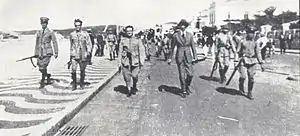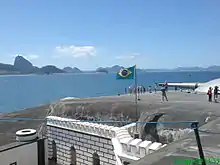Copacabana Fort revolt
On July 5, 1922, military officers stationed at Rio de Janeiro's Copacabana Fort revolted against the Brazilian government. It was the first uprising influenced by the Brazilian tenentista movement.

Tenentismo
Tenentismo is the political-military movement of various rebellions by young officers (mostly lieutenants) of the Brazilian army that occurred during the 1920s. The tenentes (lieutenants) called for reforms in the country's power structure. Among these reforms was the end of the cabresto vote (a tool of political control through the abuse of authority, the buying of votes, the use of public institutions, violence, ghost voting, exchange of favors, and fraud). Other goals included the institution of the secret ballot, and the reform of public education.
In 1922 until 1930, the tenentes constituted a minority in the officer corps. Their number was around 325, consisting of officers who graduated from Brazil's Escola Militar do Realengo.[1] By 1930, the number of these tenentes exceeded 600 or about 11 percent of the 5,255-strong officer corps on active duty. Although the 1922 revolt at Copacabana fort ended in failure, the sheer audacity by which the small band of rebels attacked a much larger force captured the attention of the public and inspired similar movements by the tenentes later on.[2] Some sources maintained that the uprising was doomed from the start because the authorities, including the Brazilian president, knew of the plot. The officers involved were also said to have accepted death.[3] These factors contributed to the way the rebels emerged as martyrs especially for their fellow soldiers.
Army reasoning
The Army reasoned that itself was the only force capable of saving the Republic. As a result, the movement was based in only one part of society, the army, and this isolated the Tenentista movement from the rest of the society.
Reasons for the revolt
On October 3, 1919, a civilian, João Pandiá Calógeras, was designated as War Minister for the first time in the history of the Brazilian Republic by President Epitácio Pessoa. Calógeras held this post until November 15, 1922.
In 1921, the Correio da Manhã, a Rio de Janeiro newspaper, published letters purportedly written by Artur Bernardes (President of Brazil, 1922-1926) and Raul Soares, Secretary of the Interior in Bernardes’s administration but earlier Secretary of the Navy in the Epitácio Pessoa administration. These letters included insults directed at Marshal Hermes da Fonseca (President of Brazil, 1910-1914), one of the most important military figures in Brazil. Their signatures were later revealed to be forgeries.
In 1922, Bernardes won the Presidential election. The Deodoro Club Militar, a traditional military school in Rio de Janeiro, and Borges de Medeiros, a well-known politician, asked a court to inspect the election results. However, the Congress recognized the elections, and their requested inquiry never occurred.
In June 1922, Epitácio Pessoa intervened in elections in Pernambuco. Fonseca strongly criticized the interference, leading Pessoa to order Fonseca's arrest and close the Club Militar.
The Copacabana Fort revolt
The revolt was supposed to include supporters in many military bases, but only a few joined in: Fort Copacabana, at Copacabana, some marginal elements from the Military village, Vigia Fort, the Realengo Military School, the 1st Engineering Battalion, navy and army members, and the 1st Military Division. The response of pro-tenentistas was weak because the government received notice that the revolt would happen and removed the crucial pro-tenentista officers from the most important military bases.

The Fort Copacabana rebels fired their cannons against many important government and military bases during the early morning of the 5th. Throughout the rest of the day, the fort was bombed. In the early morning of the 6th, Captain Euclides da Cunha and Lieutenant Siqueira Campos permitted any soldiers who wanted to leave the fort to do so; 273 of 301 left the Fort. Meanwhile, a destroyer and two battleships took up positions near the Fort and started to shell it. Captain Euclides Hermes left to negotiate, but was arrested. The government's last word to the rebels was an order to either surrender or be destroyed. The Tenentistas still inside the Fort then cut a Brazilian flag in 29 pieces, one for each rebel, and decided to march to the Catete Palace, the head office of the Executive Power. Most of the 29 remained, but only 24 [4] were left (a civilian joined then to form this number). Walking down Avenida Atlantica next to the beach, they met a combined force of loyalist troops and police at the intersection of Avenida Atlantica and the street now renamed Rua Siqueira Campos in the middle of Copacabana. Only Lieutenants Siqueira Campos and Eduardo Gomes along with four other rebels survived. A photograph first published in the daily, O Malho shows eighteen rebels. For that reason, the public still erroneously refers to those who took part in the battle on the insurgent's side as "The Eighteen of the Fort".[5]
Newspaper reports
"As forças que estão sitiando o forte de Copacabana, sob o comando do general Mena Barreto, tiveram ordem do governo para enviarem um 'ultimatum' à fortaleza, intimando-a a render-se dentro de uma hora. Em caso contrário será bombardeada por forças legais de terra e navios de guerra." O Combate, 5 July 1922.
"Na Villa Militar só houve um pequeno movimento subversivo, imediatamente abafado. Um pelotão, às ordens de um tenente, atirou contra a sala onde estavam reunidos os oficiais. O capitão da companhia a que pertencia esse pelotão, de nome Barbosa Monteiro, oficial de extraordinário valor moral e intelectual, saiu ao encontro dos soldados sublevados e recebeu uma descarga que o fez tomar morto. O pelotão, imediatamente cercado pelo resto da companhia, que acudiu, foi, com seu comandante, feito prisioneiro e desarmado. (...)" A União, 9 July 1922.
"- Nunca desejei e nunca pensei ter de assinar um ato como este, mas agora o faço gostosamente, certo de que estou prestando um serviço à República e às instituições." A Pátria, 6 July 1922.
In literature
The Copacabana Fort revolt is depicted in a highly sympathetic way in an early chapter of The Knight of Hope (Portuguese: O cavaleiro da esperanca), Jorge Amado's 1942 biography of the well-known Brazilian revolutionary Luis Carlos Prestes.
References
- McCann, Frank (2004). Soldiers of the Pátria: A History of the Brazilian Army, 1889-1937. Stanford, CA: Stanford University Press. p. 221. ISBN 0804732221.
- "Copacabana Fort, Revolt of | Encyclopedia.com". www.encyclopedia.com. Retrieved 2018-07-24.
- "Brazilian Jihad: Suicide Attack on Copacabana Beach – Part 3". Retrieved 2018-07-24.
- R. S. Rose, O homem mais perigoso do país: biografia de Filinto Müller, o temido chefe de polícia da ditadura Vargas. Rio de Janeiro: Civilização Brasileira, 2017, pp. 49, 287n
- R. S. Rose, O homem mais perigoso do país: biografia de Filinto Müller, o temido chefe de polícia da ditadura Vargas. Rio de Janeiro: Civilização Brasileira, 2017, pp. 50, 287n
- Forjaz, Maria Cecilia Spina. Tenestismo e Política. Ed. Paz e Terra.
- Borges, Vavy Pacheco. Tenentismo e Revolução Brasileira. Ed. Brasiliense.
- Ordonez, Marlene; Machado, Lizete Mercadante. História - Brasil: A Monarquia e a República - 6a Série - Col. Horizontes. Ed. Ibep.
- Torres, Iraildes Caldas. As Primeiras-damas e a Assistência Social - Relações de Gênero e Poder. Ed. Cortez.
- Besse, Susan K. Restructuring Patriarchy: The Modernization of Gender Inequality in Brazil, 1914-1940.
- Bethel, Leslie. Brazil: Empire and Republic, 1822-1930 (Cambridge History of Latin America).
- A União newspaper. 9 July 1922.
- O Combate newspaper. 5, 6, and 7 July 1922.
- A Noite newspaper. 6 July 1922.
- Correio da Manhã newspaper. 6 July 1922.